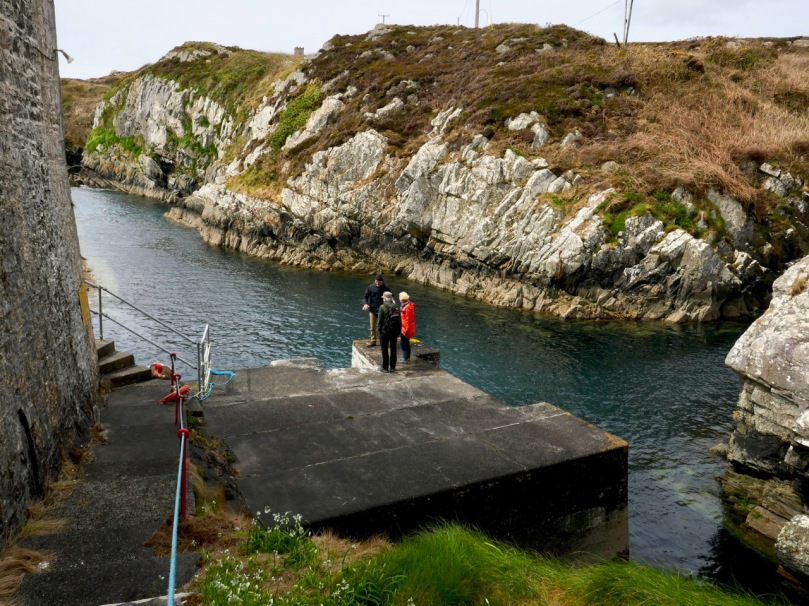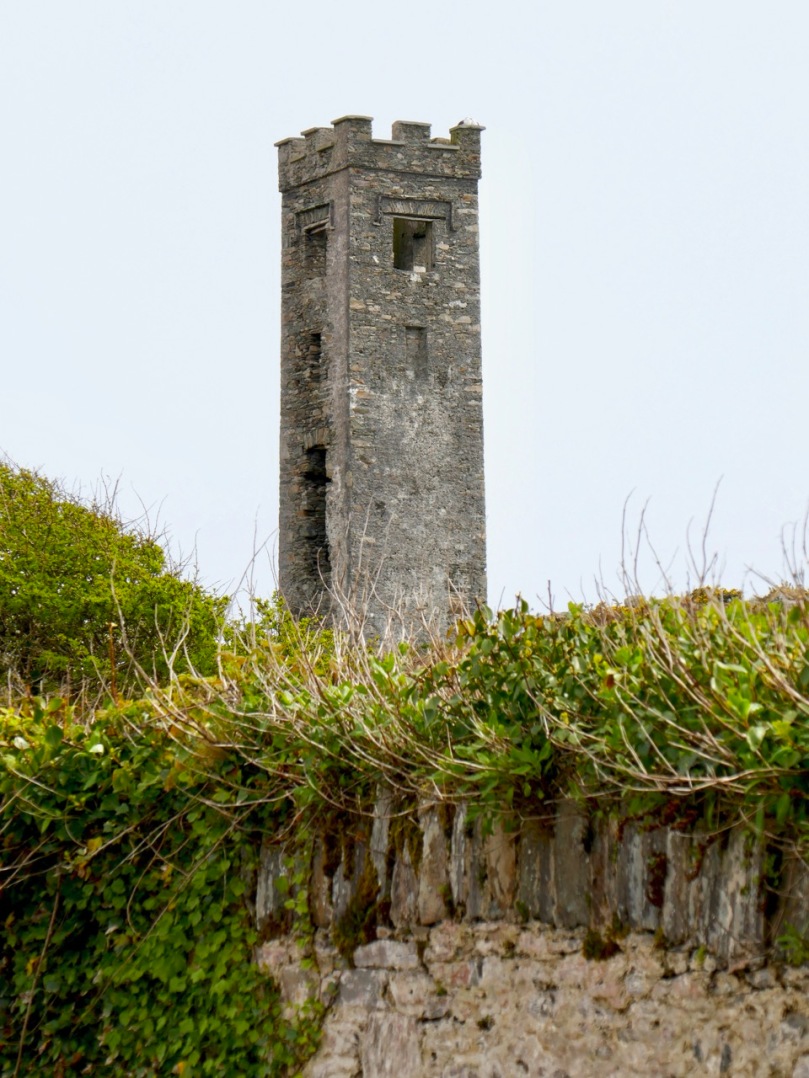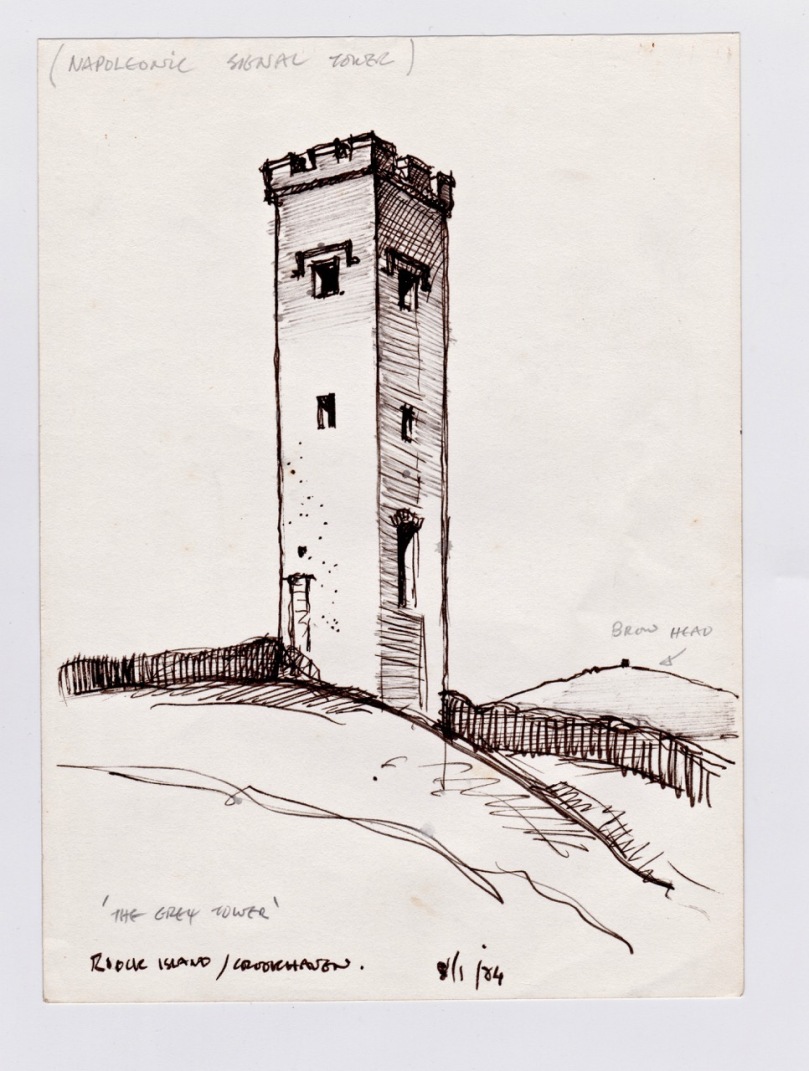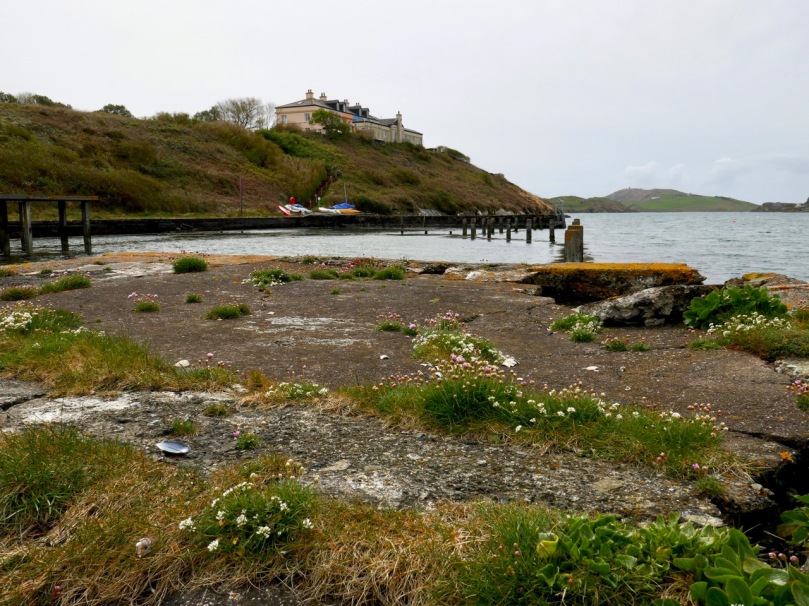It was a pleasure and a privilege this week to tour Rock Island with Aidan Power, author of the book Rock Island, Crookhaven, A Coastal Townland’s History Since 1800. Published in 2006*, this was a huge undertaking for Aidan, an amateur historian, accomplished with a high degree of professionalism and meticulously researched.
This photograph was taken from Brow Head and shows Rock Island’s location in relation to Crookhaven (foreground) and the rest of the Mizen. The furthest peak is Mount Gabriel
Aidan was living on Rock Island at the time and he knows every inch of it and every story that is embedded in the rocky soil. Today, there is only one permanent resident on Rock Island, but at its height it was home to over 100 people and a very busy place indeed. There were two populations – government employees working for the Lighthouses or the Coast Guard, and local people working in the fishing and provisioning industries.
While the lighthouse remains in the care of Irish Lights, the cottage is now in private hands and includes an ultra-modern addition with views to envy
Location was key – Rock Island is situated at the entrance to Crookhaven Harbour, a natural haven conveniently located at the extreme south west tip of Ireland – the last and first post of call for ships on the transatlantic route. As such, a Coast Guard presence was necessary, since smuggling was a way of life and foreign vessels apt to drop in or take refuge. Having sustained a French invasion by sea in 1796, the British government was on high alert for any further signs of foreign-assisted uprisings. Nearby Brow Head had a manned signal station which needed support and housing.
Lighthouse cottages
It was also the most convenient centre to build, maintain and provision two lighthouses: Crookhaven Lighthouse on Rock Island itself, and the famous Fastnet Lighthouse, 12 kms out. The east end of the Island was the centre of lighthouse-related activity. Aidan showed us the keeper cottages, one of which he had lived in but all now in use as holiday cottages. One set of houses was for the Crookhaven Lighthouse and the other for the Fastnet. He showed us where the Fastnet components had been assembled, tested and shipped out to the Fastnet Rock – a feat of engineering still breathtaking in its scope – see more about it in our post An Carraig Aonair: The Fastnet Rock.
Upper: The Fastnet assembly station. Lower: The road to the lighthouse is beautifully constructed – this lovely arch leads to the sea
The Western end was occupied by the Coast Guard end and was also the extent of the original road – see Robert’s companion piece today, The Rocky Road to Nowhere, for more about this road and the engineer who built it. The revenue officers, according to Aidan’s book, were very unpopular as smuggling was endemic on the West Cork Coast. One of the officers was called the Tidewaiter – yes, he waited for the incoming tide so he could board ships. It was a dangerous job – Aidan quotes Pococke’s account from 1752: . . .they have a term of hiding an officer, which is knocking in the head and putting him under a turf. There have been many instances of officers never heard of.
Rock Island as viewed from Crookhaven
The Admiralty started a serious crackdown on smuggling in 1816 and that’s when their lease on the West End of Rock Island began. The Coast Guard eventually became a reserve of the Royal Navy and later was controlled by the Admiralty. Its vicissitudes on Rock Island are chronicled by Aidan, including its less-than-stellar performance during the Famine. His account is exhaustive and provides a detailed picture of a British service that was deeply disliked and where the officers felt constantly under siege, culminating in a series of attacks by the IRA in 1920 and the eventual abandonment of the post that year.
Today the former Coast Guard Station has been beautifully renovated and the houses are used for holidays. They look magnificent in their flashy paint, reminders of both a colonial past and a Celtic Tiger economy.
The easterly tower
I have mentioned the two towers in a previous post, both of which have been incorrectly described in the National Monuments records and the Buildings of Ireland site. They are described as belvederes by National Monuments (see my post on Belvederes for an explanation) and as signal towers by Buildings of Ireland.
Brian Lalor’s sketch of the tower, also incorrectly identified as a Napoleonic-era Signal Tower, based on information from National Monuments
The most likely use for the westerly one, according to Aidan, was as a pilotage tower. Pilotage was a competitive business, and whoever could first see the ship at sea and get to it first with an offer of service, had a distinct advantage over others. The easterly tower was used by the Coast Guard as a look out.
At the north side of the island is a sheltered harbour which from the 1920s to the 1970s was the centre of a lucrative lobster and shellfish industry which created a certain level of prosperity in the area, until the inevitable over-fishing caused a decline in the lobster population. Today the remains of the lobster ponds can still be seen, along with a large building that was used in the 1980s and 90s as a food production facility making, improbably, garlic butter.
Upper: the remains of the quay by the lobster ponds. Lower: Aidan, Amanda, Peter and Robert on our Rock Island tour
I have only given you a flavour of Rock Island – it’s also a place where bird and plant life is abundant and where seals pop up to say hello as you wander around the coast.
Sea Campion
It’s a tranquil place from another time, staggeringly beautiful and seeping history from its pores.
This curious castellated boat shed is one of a pair on the north side
We are currently using this image as our Facebook Page header – you could mistake it for a Greek island on a sunny day
*The book is available on Amazon, or contact us for the author’s email address.
















Thanks I passed those ponds today and wondered what they were for, Hive of info on this. tks
LikeLiked by 1 person
Please could you send me Aidan’s email! I have an old photo which may interest him.
LikeLike
Always a delight to read your older posts and newer ones. Your words and mind chatterings travel me and have been my acclimatising to the wild West Ireland and Cork as in about ten days, I will be one with those elements, Miss Rain, the wild big blue. Grateful to have your journal to connect me until I am part of it.
LikeLike
Thank you, Nikolas.
LikeLike
Thank you for bringing West Cork to life with your beautiful photos and stories.
I would love to contact Aidan about the book as my 3rd great Aunts lived on Rock Island. Two sisters married two brothers: Elizabeth and Sarah Burchill married the Nicholls brothers. They were English stone masons from Cornwall working on building the Fastnet Rock lighthouse.
Thank you again, from West Cork descendant in United States, Barbara
LikeLike
Hello Barbara and thank you for your comment. I have replied by email.
LikeLike
My brother sent me this link to these lovely photos of a place I’ve only ever heard of.
The two Nicholls brothers you speak of Barbara, were Charles and Arthur Nicholls. Charles and Elizabeth were my grandparents and their son Wilfred, my father. He often told us stories about his father and his uncle Arthur, who helped to build the Fastnet Rock light house. When my grandparents returned from Ireland they settled in the Rhonda Valley in South Wales, to build homes for the miners. It seems that we are distantly related Barbara. Thank you again for these wonderful photographs, I intend to buy a copy of this lovely book.
Sincerely Sylvia.
LikeLike
Thank you for this, Sylvia. I have responded by email.
LikeLike
Ah that brings back memories of delivering perrywinkles & lobsters to the market there. Was a busy place some 50yrs ago. The French paid good money for the catch & they employed a lot of Crookers then too. Thanks for the memories!
Tom Coughlan
LikeLike
Great to hear those memories, Tom!
LikeLike
Hi Finola. Since I moved to Glengarriff to (re)open the village hostel, in July of 2017, I have been in absolute awe of the landscape of the 3 peninsulars. I look forward to reading yours and Roberts fantastic journal every week…and have trekked to most of the places written about….next stop Rock Island. Thank you. Regards Mike. Bluepool Hostel
LikeLike
What a nice comment – thank you, Mike. You live in a pretty fantastic place yourself!
LikeLike
Thanks Finola. Yes, it is pretty special! Can you please furnish me with Aidan’s contact details…his book is a must have! I’m very interested to learn more about local history…by local I mean the 3 peninsula..any reading suggestions you may have will be welcome! I’m particularly interested in stone circle’s, churches, tombs etc. Many thanks Finola
LikeLike
It was a real pleasure to show you around and meet those responsible for such a great journal. Yet again two very informative pieces with great photographs.
LikeLike
Hi Finola,
Can you send me Aidan’s email address so I can buy the book? My grandmother was from Goleen, her family owned the shop there, her brother was the last blacksmith in Goleen. I live in America now but we still have a house in Goleen, I go home every summer.
I read both posts every week, Thank You for for bringing a smile to my face every Sunday.
Happy New Year
Anthony
LikeLike
Replied by email.
LikeLike
What a superb day out it was and so interesting, especially with Aidan on hand with all the info. Some evocative photos too Finola; I especially like the lighthouse and the coastguards houses
LikeLike
Some of the photos were taken on a sunnier day – no more photogenic place on the planet, I think!
LikeLike